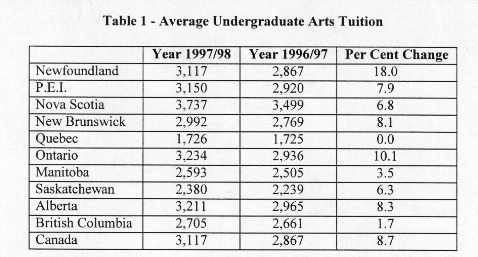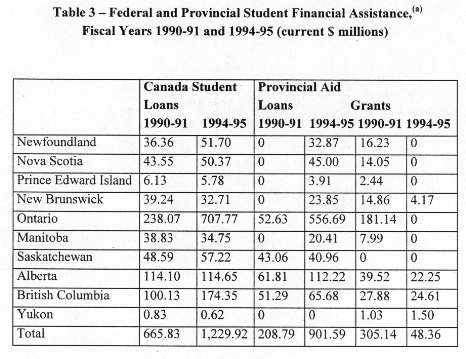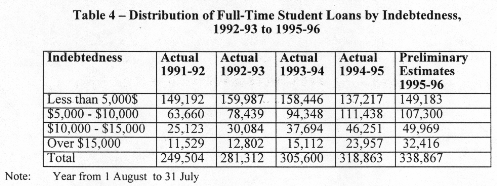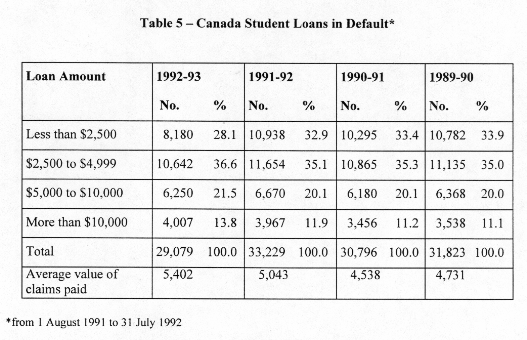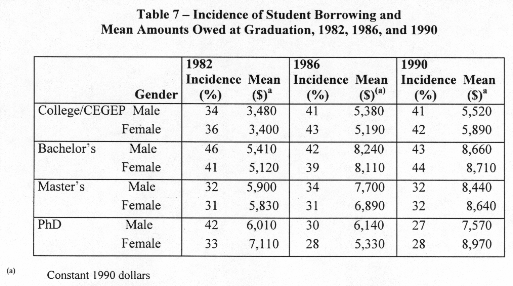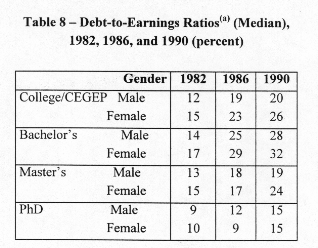BP-460E
FINANCING UNIVERSITY
EDUCATION
Prepared by: TABLE OF CONTENTS THE RISING COST OF UNIVERSITY EDUCATION A. Canada Student Loans Program (CSLP) B. Ontario Student Assistance Program (OSAP) C. Programme de prêts et bourses du Québec THE ROLE OF FINANCIAL INSTITUTIONS A. Magnitude of Student Indebtedness B. Effects of Student Indebtedness C. Government Solutions to Canadian Student Indebtedness 1. Canada Student Loans Program (CSLP) 2. Ontario Student Assistance Program (OSAP) 3. Programme de prêts et bourses du Québec C. Income Contingent Repayment Loans Schemes
FINANCING UNIVERSITY EDUCATION In recent months, the phrase "crisis in education" has appeared often in newspapers and magazines and on radio and television. The phrase has been used in the context of government funding to education, rising tuition at most Canadian universities, and increased debt loads for students and recent graduates. It is useful to go beyond the phrase to quantify recent developments and to speculate about their short-run and long-run effects. Although funding cuts affect all levels of education, this paper will concentrate on their impact on postsecondary education in Canada. Since the recent surge in tuition fees has given student loans more prominence, this paper examines the federal program and two representative provincial student loan programs and notes the increasing role of financial institutions in these. The central section of the paper gives the available data on the extent and nature of student indebtedness and discusses some of its apparent effects. Related issues discussed in this paper include the reports of two parliamentary committees, a recent federal education initiative and a possible alternative to the current system of student loans. THE RISING COST OF UNIVERSITY EDUCATION At the end of August 1997, Statistics Canada released the article "University Tuition Fees, 1997/98" in The Daily, showing that the cost of university tuition was increasing much faster than the rate of inflation. Fees for undergraduate arts students (a long-standing proxy for the general level of university tuition) had increased by almost 9% in Canada from the 1996-97 academic year. This percentage is the average across Canada; as the following table shows, changes in tuition costs varied widely among provinces, from no change in Quebec to a change of 18% in Newfoundland.
Source: Statistics Canada, "University Tuition Fees, 1997/98," The Daily, 25 August 1997. Fees shown are in dollars and are an average of the universities in each province with the fees weighted by the number of students. Tuition, of course, is only part of the cost of higher education. Additional fees can add up to several hundred dollars. At the University of Toronto, for example, such fees for an undergraduate arts student would run from $133 to $467 (or 4.1 to 14.6% of the University of Toronto’s $3,196 tuition -- all figures based on Statistic Canada's recent release). The costs of room and board for those who cannot attend a local university (or choose not to) are higher than tuition fees. Total expenses for attending the University of Toronto for the 1997-98 academic year range from $8,328 to $10,940; the U of T is admittedly in one of Canada's most expensive cities, but average total expenses across Canada are probably in the $7,000 to $8,000 range. With respect to tuition fees, as shown in the table above, Quebec stands out, both for its low level of tuition costs and for having had no increase in such costs since the 1996-97 academic year. The tuition figure shown is for provincial residents; those from outside Quebec pay higher course fees, bringing the cost of their education in Quebec into line with tuition charges at universities in other provinces. With the exception of Quebec and British Columbia, which had a relatively modest increase in tuition, universities in Canada had tuition increases far in excess of the current inflation rate of under 2%. The Statistics Canada study noted that tuition fees have outpaced the rate of inflation in all provinces since the mid-1980s. Tuition fees have more than doubled while the consumer price index (CPI) has increased by 37% (because of limited data, the comparison was for the period 1985-86 to 1995-96). Some commentators have wondered, however, whether the real cost of tuition is so far different from what it was in (say) the mid- or late-1960s. The phrase "crisis in education" could prove to be an overstatement if it could be shown that earlier students and their families managed to pay tuition costs that were higher in real terms than they are now. Chart 1 provides a historical perspective on tuition movements since the mid-1960s. Three series are shown in the chart: average tuition for full-time Canadian undergraduates in the Arts and Sciences in nominal terms, the consumer price index (CPI) and real tuition costs (the nominal series divided by the CPI). Each of the three is shown as an index with 1965=1.0. Most noticeable in the chart, perhaps, is the surge in tuition costs over the past few years. Other facts are worth mentioning, however. Inflation was relatively flat during the earliest and latest years covered; the high inflation during the 1970s and 1980s also stands out. It is possible to discern three sub-periods of movement in tuition relative to inflation. From the mid-1960s to the late 1970s, tuition stayed relatively flat, almost immune to changes in prices. Throughout the 1980s, tuition changes were somewhat in line with price changes, as if universities (or whoever set tuition fees) were trying to maintain the real revenue from tuition. From the late 1980s, the price of tuition has moved up faster than prices. Of most interest in the chart is the movement of real tuition costs. It is only in the mid-1990s that real tuition costs -- one measure of the burden of tuition on students and their families -- reached the level of the mid-1960s. The saucer-shaped curve for real tuition may, however, give a misleading impression of the burden of recent tuition increases, since real incomes are higher now than they were in the mid-sixties. According to Statistics Canada’s surveys on income, real family income was 62% higher in 1995, the year when real tuition reached its mid-sixties level, than it was in 1965. That is, the real burden of tuition, relative to family income, is lower today than it was in the 1960s. Comparing 1995 to a year in the mid-1970s would give a different picture, as real family income has been relatively flat since then. The distribution of family income is also important. If most students in the mid-1960s came from families with "high" incomes (high relative to the family incomes of today’s students), a comparison using average family income would understate the real overall burden of tuition today. Another way of looking at tuition changes is to explore how revenue from tuition has changed as a source of funds for universities. Chart 2 uses the available data for the period 1971-72 to 1995-96 to show the ratio of tuition fees to operating revenues. This ratio declined from its early 1970s value of around 18% and did not regain this level until the early 1990s. By the 1995-96 academic year, the ratio had reached 25.6%. Note that the series used in this chart is the aggregate dollar amount for tuition fees at Canadian universities. The tuition series here reflects both changes in tuition fees and changes in enrolment. Despite the different definitions, both charts illustrate universities’ increased reliance on tuition.
Postsecondary students have various sources of funds for their education: family income (parents, spouse, grandparents), wages from work or any other personal income source, scholarships, loans from the bank and grants and loans from the government. It is the loans from government that have attracted the most attention, as these loans can reflect government policy on education. In Canada, the federal and provincial governments provide financial assistance (loans and/or non-repayable grants) to eligible students based on their demonstrated financial need. The needy students of all the provinces except Quebec and the Northwest Territories may apply for both federal and provincial assistance, using one form to do so. Quebec and the Northwest Territories have opted out of the Canada Student Loans Program (CSLP) and receive compensation from the federal government based on the costs of their own student assistance programs. The loan programs take into consideration any contribution from family and income from work during the four months before the beginning of the studies; that is, all the resources available to the student and the cost of his or her studies are calculated. The next section describes the Canada Student Loans Program (CSLP) and the Ontario Student Assistance Program (OSAP), which was chosen to represent provincial programs in all those provinces with CSLP. A description of the Programme de prêts et bourses du Québec is also given. A. Canada Student Loans Program (CSLP) In 1994, there were a number of modifications to the CSLP program, which was renamed the "New CSLP." Table 2 compares the two versions of CSLP. The New CSLP provides for up to 60% of the assessed needs of the student up to a weekly loan limit of $165. During full-time studies, the student does not make payments on the loans and the interest is paid by the government. Six months after the end of their studies, the students are required to begin to repay the loan. Participating provinces determine how much assistance they themselves will provide in loans and/or grants.
(a) While the student is in school and the
government is paying the interest, a loan is classified as class A. Once the borrower
leaves school and must assume responsibility for payment of interest, the loan is
classified as class B. Source: Harry Hassanwalia, "Improvements to the Canada Student Loans Program: Do Recent Changes Fit the Bill?" in Ross Finnie and Saul Schwartz, "Student Loans in Canada. Past, Present and Future." C.D. Howe Institute, Toronto, 1996, and Library of Parliament. For part-time students, there is also the possibility of a loan of up to $4,000, on which interest must be paid by the student during his or her studies. Canada Student Loans are issued by and repaid to participating lenders. There is a program of interest relief for students who experience financial difficulties after their studies. Some provinces provide additional assistance, in the form of loan remission or loan forgiveness, to borrowers repaying provincial student loans. Federal assistance also includes Special Opportunity Grants for students with permanent disabilities (up to $3,000 per year), high-need part-time students (up to $1,200 per year) and female doctoral students in certain fields of study (up to $3,000 per year for up to three years). Until 1990-91, almost all the provinces gave needy students some form of grant or bursary. By 1994-95, most of these aid packages had been eliminated, leaving only loans. Some provinces were more affected than others. In Ontario before 1993-94, needy students were first given a provincial grant and then a federal loan; a provincial loan was then offered if still more was needed to match the assessed need. In 1993-94, the grant program was abolished, however, making the CSLP loan the first type of aid offered to the student. The main exception to this situation is British Columbia; here the grants programs were maintained, with the result that the amount borrowed by students rose only moderately. Government financial assistance to students is thus a combination of federal and provincial packages. Table 3 shows the federal and provincial student assistance for the years 1990-91 and 1994-95.
(a) Omitting Quebec and the Northwest Territories. Source: Ross Finnie and Saul Schwartz, "Student Loans in Canada. Past, Present and Future," C.D. Howe Institute, Toronto, 1996. B. Ontario Student Assistance Program (OSAP) OSAP includes both federally and provincially funded loan programs that provide financial assistance to eligible postsecondary students. The Government of Ontario funds the Student Loans Plan and the Ontario Special Bursary Plan (OSBP). The latter is a student assistance program that offers non-repayable bursary assistance to help cover the educational expenses of part-time and full-time postsecondary students with a low family income. In addition, there are the Ontario Work Study Plan, which is a special program giving students a chance to get part-time jobs on campus; the Child-Care Bursary Plan, which offers help for students with three or more children; and the Bursary for Students with Disabilities. Finally, there is the Loan Forgiveness Program (for students receiving loans through OSAP); and the Interest Relief Program, which is for Ontario Student Loans only. C. Programme de prêts et bourses du Québec The Programme de prêts et bourses du Québec provides financial aid to postsecondary students and those receiving secondary school job training. The calculation of allowed expenses includes tuition fees, subsistence, and transportation costs as well as expenses for children, some medical expenses and the interest on computers bought under the Loan Program for the Purchase of a Computer. The revenues of the student are also taken into account, as is the contribution of his or her parents and/or spouse if applicable. The difference between income and costs is provided in loans up to a certain amount and the rest is provided through grants. THE ROLE OF FINANCIAL INSTITUTIONS In all governmental programs offering funding to needy students, financial institutions play an important role. This role has grown in recent years, especially with respect to the CSLP. In June 1994, the federal government adopted Bill C-28, which gave financial institutions broader responsibilities in the area of student financial assistance. Since then, the government has ceased to guarantee student loans; instead, it pays a 5% risk premium to participating lenders, who agree to provide student loans. There are now nine lenders, which are required to disburse loans promptly within a specified period of time, provide service in both official languages, have toll-free telephone enquiry lines, give written notice and annual statements to borrowers who are repaying the loan, and offer financial counselling. The government still decides on the amount of the loan for each applicant; the financial institutions do not take part in the decision process. The interest on the loans is paid by the government while the student is in school and, after six months following the period of studies, the student must begin to pay the interest and repay the outstanding capital. This reimbursement is negotiated between the student and the financial institution. Borrowers who were full-time students have the option of fixed interest rates of prime plus up to 5% or floating rates of prime plus up to 2.5%. With the recent increases in tuition fees at most Canadian universities and the shift of some government assistance from grants to loans, student indebtedness has risen. This section looks at various aspects of student indebtedness. Some of the tables, unfortunately, rely on data from the late 1980s or early 1990s, and may thus understate the increasing burden of student debt in recent years. A. Magnitude of Student Indebtedness Table 4 shows the distribution of full-time student loans by indebtedness for the period 1992-93 to 1995-96. Note that there is a general upward trend over the years for each category of indebtedness and thus in the total.
Source: Human Resources Development Canada, 1994-95 and 1997-98 Estimates Part III. Table 5 shows the number and the percentage of student loans in default by loan amount for the period 1989-90 to 1992-93. Note that, in total, the number of loans in default was lower in 1992-93 than in 1989-90. Also, the average value of claims paid went up over that period.
Source: Bernard Bourgouin, "Financial Assistance to Postsecondary Students," In Statistics Canada, "Education Quarterly Review," Publication No. 81-003 Quarterly, Spring 1995, Vol. 2, No. 1. Table 6 shows the number of bankruptcies declared by CSLP recipients; this number in 1995-96 was more than twice that in 1990-91. The number of bankruptcies is growing very fast and this growth has become an important concern for lenders and government policymakers.
Source: Government of Canada, Human Resources Development Canada, Learning and Literacy Directorate. Source: Canadian Federation of Students, "A Blueprint for Access, A Strategy for Change," Canada, 4th ed. 1997. The following tables are based on data from the National Graduates Surveys. Table 7 shows the incidence of student borrowing and the mean amounts owed at graduation by gender. The data in Tables 7 and 8 are unfortunately not recent; information from the 1998 Budget suggests that average student debt next year will be about $25,000. The fact that the numbers are quite similar for men and women is interesting, because men usually earn more than women. The incidence of borrowing for college/CEGEP and BA students has grown over time, while it has remained stable for MA students and decreased for PhD students. However, the mean amount borrowed has increased for all types of students.
Source: Ross Finnie and Saul Schwartz. "Student Loans in Canada. Past, Present and Future," C.D. Howe Institute, Toronto, 1996. The debt-to-earnings ratios, shown in Table 8, are increasing for all types of students, with the biggest increase (roughly double) for those graduating with a bachelor’s degree. Also, except for PhD graduates, the burden is heavier for women than for men; this might have been expected since, as explained above, men usually earn more than women. Note, however, that the burden decreases as the level of the degree rises.
(a) Defined as the amount owed to student loans programs at graduation divided by annual earnings in the job held at the first interview. Source: Ross Finnie and Saul Schwartz. "Student Loans in Canada. Past, Present and Future," C.D. Howe Institute, Toronto, 1996. Table 9 presents the reasons for difficulties in repaying loans, as reported by students in interviews. The interesting fact here is that high debt load was not said to be the most important factor; rather, this was said to be unemployment or insufficient earnings.
(a) Too few observations to be reported. Note: Data for those with student debt (government or otherwise) still outstanding at the first interview, two years after graduation. The rows add up to more than 100% because individuals may have indicated multiple causes. Source: Ross Finnie and Saul Schwartz. "Student Loans in Canada. Past, Present and Future," C.D. Howe Institute, Toronto, 1996. Part of the default problem under the Old CSLP seemed to stem from certain features of the program (Finnie and Schwartz (1996). First, defaulting on a student loan could not affect a borrower’s credit rating, since CSLP regulations forbade the release of this information to a credit bureau. Second, the relatively small size of student loans and their below-market interest rates gave the banks less incentive to pursue repayment. Finally, the repayment terms were quite rigid. Most students faced a standard repayment period and payments set only by the extent of their borrowing. B. Effects of Student Indebtedness Table 10 presents the education decisions taken by students after obtaining their first and second degrees. The numbers show that those who had obtained a master’s degree by 1988 had had a much lower incidence of borrowing at the bachelor’s level.(1) The relationship is similar for those who obtained a master’s degree by 1991. The same pattern holds for the master’s graduates who went on to obtain a PhD by 1988. (The situation is not so clear for those who received their PhD by 1991, but as Finnie and Schartz (1996) have pointed out, since there were fewer of these individuals, the situation of those who received their PhD by 1988 is more significant.) Finnie and Schwartz mentioned three reasons for the fact that those who went on to higher studies borrowed less than others at the earlier stages. First, continuing students are generally the better students and they were therefore more likely to receive bursaries or scholarships, thereby reducing their demand and eligibility for loans. Second, individuals from families with high incomes have less need for loans, should not be eligible for loans and are more likely to go on to higher levels of studies. Third, the fear of high levels of accumulated debt may have deterred some individuals from continuing their studies.
(a) Constant 1990 dollars. Source: Ross Finnie and Saul Schwartz. "Student Loans in Canada. Past, Present and Future," C.D. Howe Institute, Toronto, 1996. C. Government Solutions to Canadian Student Indebtedness There has long been pressure on governments to do something about the burden of student debt. As policies differ according to the program and level of government, the discussion below is under the following headings: Canada Student Loans Program (CSLP), Ontario Student Assistance Program (OSAP) and Programme de prêts et bourses du Québec. 1. Canada Student Loans Program (CSLP) Under this program, as mentioned earlier, borrowers experiencing financial difficulties will have relief on interest and repayment of capital for three-month periods, for a maximum lifetime benefit on full-time loans of up to 30 months within the first five years of repayment. To help Canada Student Loans Program borrowers whose financial circumstances make it difficult for them to repay their student loans, the 1998 Budget introduced modifications to the program. These modifications consisted of interest relief, extension of the repayment period, extension of interest relief, debt reduction, and other measures. Interest relief came into effect in April 1998; a person can earn more and still be eligible for interest relief since the qualifying income thresholds have been raised by 9%. Beginning in 1999, partial interest relief will be available for graduates further up the income scale who are facing financial difficulty. The repayment period will be extended to 15 years for individuals who have exhausted 30 months of interest relief. This will lower monthly payments by nearly 25% at current interest rates. Interest relief will also be extended, from 30 months to up to 54 months during the five years after leaving school, if, even after the repayment period has been extended to 15 years, an individual remains in financial hardship. Debt will be reduced for the minority of individuals who remain in financial difficulty after all these relief measures have been implemented. Effective this year, the government will reduce the loan principal if annual repayments exceed, on average, 15% of the individual’s income. The maximum amount of assistance will be $10,000 or 50% of the loan, whichever is less. To qualify, five years must have passed since the completion of studies and the individual must have exhausted interest relief. To ensure that Canada Student Loans continue to provide as much assistance as possible to those who need them, the government is taking steps to ensure that both educational institutions and students use the program as it is intended. These steps include:
The federal government will work with the provinces that participate in the Canada Student Loans Program to better coordinate federal and provincial student financial assistance and move toward a single loan product. 2. Ontario Student Assistance Program (OSAP) In February 1998, the Ministry announced changes to Student Assistance. These follow the business plan objective of reducing the overall default rate to less than 10% within the next five years. The changes include:
3. Programme de prêts et bourses du Québec Amendments were made to the law on 19 December 1997. They were designed to help the government recover a bigger part of the lost revenue than was previously possible and to help students manage their debt. As a result of the amendments, the government will:
With recent increases in tuition and the accompanying rise of student indebtedness, the financing of university education has become a prominent concern. Parliamentary committees have been devoted to issues in postsecondary education; there have been announcements of government initiatives in the area and attempts to find alternatives to the current system of financing university education. In December 1997, two committees presented their reports. The first report, from the Committee on Human Resources Development and the Status of Persons with Disabilities, chaired by Reg Alcock, M.P., was entitled "Ensuring Access: Assistance for PostSecondary Students." The main recommendations were:
The other report was presented by the Special Senate Committee on Postsecondary Education, chaired by Senator Bonnell. It recommended that the federal government:
Experts agree that the 1998 Budget was dedicated to education. The Canada Millennium Scholarship Endowment is the biggest investment, at $2.5 billion. Intended to reward academic excellence, it will provide an announced 100,000 scholarships, beginning in the year 2000, to help low- and moderate-income Canadians attend universities and colleges. The scholarships will be given to full- and part-time students each year over 10 years. Other important measures are the Canada Education Savings Grant, increased funding to the three granting councils, Canada Study Grants, and Tax Relief for Interest on Student Loans. The Canada Education Savings Grant will benefit families who save for their children’s education through registered education savings plans. The increased funding to the granting councils is aimed at supporting advanced research and graduate students. The Canada Study Grants will help over 25,000 needy students with children or other dependants with a grant of up to $3,000. Tax Relief for Interest on Student Loans will give all Canadians tax relief on interest payments on their student loans; effective this year, individuals will be allowed to claim a 17% federal tax credit on the interest portion of the amount of loan repaid in the current year. The credit will apply to interest payments on loans under both federal and provincial student loan programs. Since the bill related to this budget has only passed first reading, changes could still be made to these guidelines. C. Income Contingent Repayment Loans Schemes As student indebtedness rises, so does the risk of loan defaults. This is especially true for those who do not find well-paying jobs after their schooling ends. With traditional loans, the debtor must pay a proportion of the outstanding loan and accrued interest each month. This payment could be a very high proportion of the debtor’s monthly income, and in some cases -- if the debtor does not find a job after school or is laid off -- there may simply be no income from which to repay a loan. One proposal is for loan repayment to be linked directly to a debtor’s income -- the so-called Income Contingent Repayment (ICR) loan scheme. This proposal has been around for decades but seems to be taken more seriously today. The proposed ICR can take many forms, but all have basic elements in common. A student borrows a certain amount and agrees to pay a certain proportion of future income toward the loan (say, 0.7% of income for every $1,000 borrowed). The proportion depends on several factors, such as the life of the loan and the definition of income, which can be pre-tax or after-tax income or an amount above some arbitrarily specified level. The proportion of this income, however defined, is similar to an income tax rate; several ICR proposals have suggested using the income tax system to collect the loan repayments. Although an ICR scheme might solve the problem of defaults, except, perhaps, for those who leave the country or leave the workforce, there are some specific concerns, the two most important of which are related: the opportunity for adverse selection by borrowers under the scheme and the ability of an ICR scheme to be self-financing. Under adverse selection, those students expecting relatively low future income -- say, an English major who intended to become a poet -- would opt for an ICR scheme because they knew that the ICR would allow them to pay less than they would with a traditional loan. Some suggest that the ICR schemes could be self-financing because those with above-average incomes would pay enough to compensate for those with below-average incomes. Unfortunately, such projections break down, as those who expect relatively high future incomes (doctors, for example) would be likely to find alternative ways of financing their schooling. Those left in the ICR scheme (poets and those expecting relatively low future income) would probably not pay enough to make the scheme self-financing, unless the proportion of income to be repaid was set very high. It may be possible, however, to construct an ICR scheme that, while not completely self-financing, would be less costly to the government than the current student loan system. The fiscal problems of governments have affected Canadian universities and their students. At the federal level, cutbacks in Established Programs Financing (EPF) and Canada Health and Social Transfer (CHST) have led to reductions in the revenues of provincial governments. These reductions have been felt in the areas financed by the provinces, of which education is, of course, one. When the universities faced lower government support, they responded, in part, by raising tuition fees. Provincial governments also reduced direct spending on students by replacing student grants with loans. The immediate result from the students’ viewpoint has been a higher cost for university education. For those without the financial resources to bear this higher cost, the result has been higher student indebtedness. It is unlikely that these trends in university finances will be reversed in the near future. Although it is still too early to pin down the effects of the changes in university finances and student indebtedness (some of the available data on student debt come from the late-1980s and early-1990s and thus do not capture the recent surge in tuition fees), policymakers are attuned to the concerns of current students. The two recent reports by parliamentary committees have focused attention on issues discussed in this paper and should help shape future government policy, as could already be seen in the 1998 Budget. Bourgouin, Bernard. "Financial Assistance to Postsecondary Students." In Statistics Canada, "Education Quarterly Review," Publication No. 81-003 Quarterly, Spring 1995, Vol. 2, No. 1. Canadian Federation of Students. "A Blueprint for Access, A Strategy for Change." Canada, 4th ed. 1997. Finnie, Ross and Saul Schwartz. "Student Loans in Canada. Past, Present and Future." C.D. Howe Institute, Toronto, 1996. Hassanwalia, Harry. "Improvements to the Canada Student Loans Program: Do Recent Changes Fit the Bill?" in Ross Finnie and Saul Schwartz, "Student Loans in Canada. Past, Present and Future." C.D. Howe Institute, Toronto, 1996. Human Resources Development Canada. "Canada Student Loans Program." Internet site: http://www.hrdc-drhc.gc.ca/prets_aux_etudiants/. Human Resources Development Canada. "Lloyd Axworthy Announces Major Changes to Canada Student Loans Program." News Release, 1 August 1995. Lewington, Jennifer. "Simplify Student Loans, Senate Panel Recommends." Globe and Mail (Toronto), 18 December 1997. Ministère de l’Éducation du
Québec. "Aide financière aux études." Internet site: Ontario Ministry of Education and Training. "OSAP." Internet site: http://osap.gov.on.ca/. Talaga, Tanya and Vinay Menon. "MPs Urge Student Loans Aid for Jobless." Toronto Star, 13 December 1997. Thomas, Terrence J. "Income-Contingent Student Loans." Background Paper-373, Library of Parliament, Ottawa, January 1994. Treff, Karin and Ted Cook. "Finances of the Nation." Canadian Tax Foundation, 1995.
(1) It does not matter that the initial average loan levels at the bachelor’s level were higher for those who went on to a master’s degree. The much lower proportion of master’s graduates with loans means that a large number of the master’s graduates started their loan balances at zero when they entered graduate school.; that is, those who went on to a master’s degree had assumed less debt at the bachelor’s level. |
